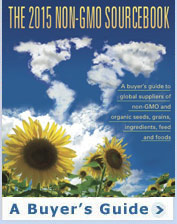Clarkson pioneers market for organic lecithin
When it comes to locating supplies for organic lecithin, food manufacturers can choose from Clarkson Soy Products and… well that’s about it. Actually, there is a French company, Biopress Huilerie, and an Indian company, Mudar India Exports, that also sell organic lecithin, but Clarkson was the first company to develop organic lecithin and is the world’s leading supplier.
Creating the organic lecithin market wasn’t easy, and it took four years to develop the right process to make organic lecithin.
The seed idea to manufacture organic lecithin sprouted back in 2000, says Curtis Bennett, vice president and operations director at Clarkson Soy Products. The growing demand for organic food products led to a demand for an organic lecithin as an ingredient. “We thought ‘if we build it, the market will come.’”
“Tip of the tail on the dog”
Lecithin is a versatile ingredient used in a variety of processed foods, baked goods, and confections, such as chocolate. It is mainly used as an emulsifier to make ingredients, such as water and oil, blend together.
Conventional lecithin is a by-product of soybean processing. Soybeans are crushed to make flakes, which then enter an extractor to produce soybean oil, using a distillation process involving a hexane solvent. Lecithin is separated from the oil by adding water and and subjecting it to centrifugal force, and it is then purified.
The problem with producing lecithin is that a large volume of soybeans must be crushed to produce a small amount of lecithin. As a rough example, 100 tons of soybeans would produce 85 tons of soymeal and flour, 10 tons of soy oil, and just three-fourths of a ton of lecithin. As Lynn Clarkson, managing director of Clarkson Soy Products, says, “It is absolutely the tip of the tail on the dog.”
Challenges developing equipment
National Organic Program rules prohibit the use of hexane in organic food processing, so Clarkson Soy Products had to develop a physical process to separate lecithin from the soybean oil.
Bennett says there were many challenges in developing equipment to process organic lecithin. In addition to hexane, there were other materials used in conventional lecithin production that couldn’t be used in organic. Clarkson also had to start from scratch since no one else had produced organic lecithin. “We had no model to follow,” Bennett says.
There was a lot of trial and error. Several processing machines were custom built and failed to work. “It’s really difficult to control the process (of making lecithin),” Bennett says.
Bennett conducted intensive research, attended conferences, and searched to find the right experts to put the project together.
The market response indicating demand for organic lecithin encouraged Bennett to continue. “The demand was there. We had a lot of excitement from companies around the world,” he says.
Commercially available to meet NOP rules
After several years, “we finally got the process under control,” Bennett says. They sent organic lecithin samples to a leading conventional lecithin company and asked them to critique it. “They couldn’t believe it was organic,” Bennet says. They were so impressed that they visited Clarkson’s facility and asked for the marketing rights.
Clarkson introduced its organic lecithin, which is in liquid form, in January 2004.
Today, Clarkson ships organic lecithin to customers worldwide, including companies in Europe, Japan, South Korea, Australia, and of course North America. These companies use the lecithin in organic cereals, cosmetics, power bars, breads, cookies, and chocolate. Nutritional supplement companies put the liquid lecithin into gel caps to sell as supplements.
“We think we have a very nice product, and it is well received around the world,” Bennett says.
Meeting the demand is not a problem, Bennett says. “Our plant is operating at one-tenth of its capacity. There is no problem with commercial availability.”
Bennett refers to a term in the National Organic Program rules about the requirement for organic ingredients. If commercial quantities of an organic ingredient are not available, organic food manufacturers can use a non-organic substitute. Organic food companies have been able to use unbleached conventional lecithin. With organic lecithin now available, it is harder for organic food companies to get by with using conventional.
Bennett says the NOP must be stricter about requiring the use of organic minor ingredients that are commercially available. “Once the rule is fully enforced we will see more organic ingredients like lecithin become available.”
Addressing GMO concerns
Another challenge for organic food manufacturers using conventional lecithin is the GMO issue. Because lecithin is made from soy, which has been genetically modified, there are GMO concerns. Some organic manufacturers have been using identity preserved, non-GMO lecithin to avoid the GMO threat.
“GMOs are a big concern to end users,” Bennett says.
Clarkson ensures there are no GMO threats by buying organic soybeans and testing them for GMOs upon arrival at the lecithin facility using the DNA-based PCR method. “Anything that tests above 0.1% is rejected,” Bennett says.
Clarkson has never had a quantitative PCR GMO test detect any GM material.
Expansion plans
With the success of their organic lecithin project, Clarkson Soy Products plans to expand. They already expanded their plant’s capacity in 2007. They are currently researching and developing a powdered lecithin, which would expand Clarkson’s capabilities to meet their customers’ needs. “Powdered lecithins are used in commercial applications in food systems where liquid lecithin is more difficult to handle,” Bennett says.
Overall, he says Clarkson is well-positioned in the organic lecithin market. “It’s exciting being an exclusive for an ingredient used in so many applications.”
© Copyright The Organic & Non-GMO Report October 2008




